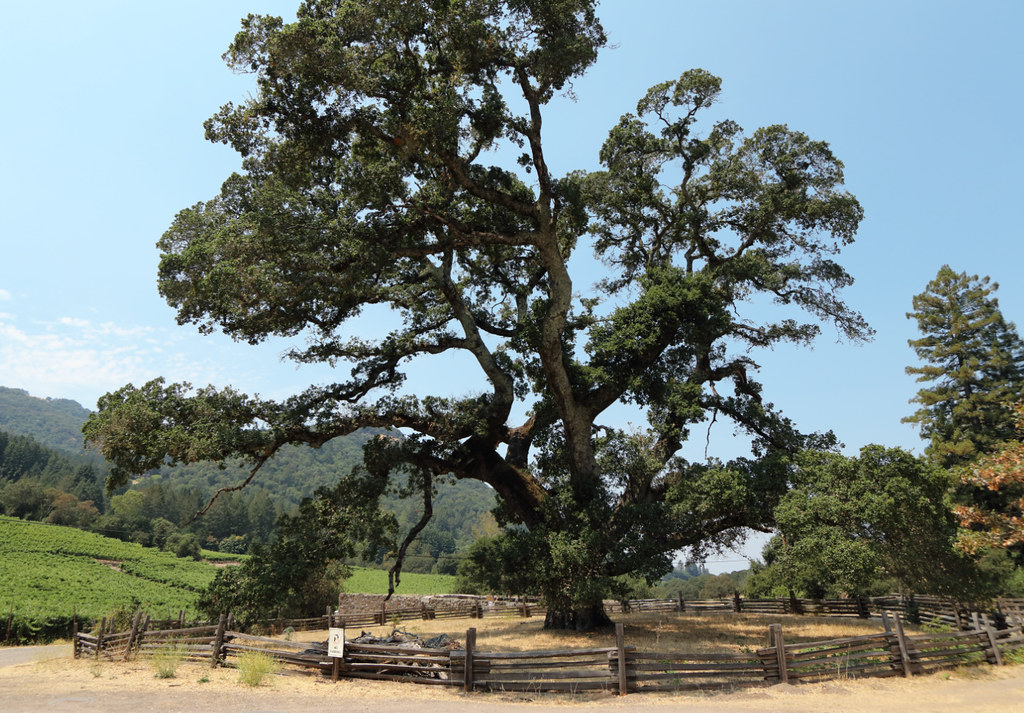
In November, scientists discovered a new ambrosia beetle in symptomatic valley oaks (Quercus lobata) trees in Calistoga, Napa County. Some blue oaks (Q. douglasii) have also been attacked (Rabaglia et al. 2020). Trees associated with this outbreak showed wilting, defoliation, and broken branches. The infested wood was discolored, presumably by the fungus. The insect, Xyleborus monographus, is native to Europe.
Officials now know that this beetle is found throughout a 15-mile-long area in Napa and neighboring Lake and Sonoma counties. It has probably been there for several years (Rabaglia et al. 2020). One specimen of the beetle was trapped in Portland, Oregon in 2018, but no infestation was detected. The beetle has never been intercepted in California. Nor has it been found in traps designed to detect bark beetles which have been deployed in 11 counties – including several in the San Francisco Bay area but not including Napa or Sonoma.
Like all Xyleborus, adult females tunnel into tree’s trunks, carrying fungal spores in their mycangia (structures in the jaws in which microbes are harbored). Beetle larvae eat the fungi. Beetle reproduction is facilitated by sibling mating within the gallery and by the ability of unmated females to produce male offspring.
Sometimes the beetle’s associated fungi are pathogenic to living trees. One of the fungal species detected in the Calistoga infestation is Raffaelea montetyi, which is reported to be pathogenic to cork oak. The presence of this fungus had been reported in 2018, although the beetle species carrying it was not identified then. This is apparently the first report of this fungus in North America.
Known hosts of beetle X. monographus include European or Eurasian chestnut (Castanea sativa), beech (Fagus orientalis), and European and American oaks (including Q. lobata and Q. rubra). The possible effects of the beetle and associated fungi on other oak species is unknown. Oaks are acknowledged to be important components of forests and woodlands in California. Ambrosia beetles often attack stressed trees. Since California forests are increasingly frequently stressed by drought, fire, and other pests, they might be especially vulnerable.
The California Department of Food and Agriculture is currently seeking comments on what pest rank to assign the insect. The comment period closes on March 6th and I encourage you to consider providing your views.
In their draft document ranking risk, state officials note that a proven host — Q. lobata — is widespread in California and the insect is probably capable of establishing over much of the state. The possible economic impact was described as possibly affecting production of oaks in California nurseries and triggering quarantines. (Does this mean CDFA expects impacts only on saplings? Is this realistic? CDFA made no mention of costs to urban areas for hazard tree management.)
The risk assessment notes that research by McPherson, et al. (2008) found that ambrosia beetles are attracted to oak trees already infected with sudden oak death (SOD) (Phytophthora ramorum). Therefore, X. monographus could have a synergistic impact with SOD on California oaks – which has already killed an estimated 1.9 to 3.3 million coast live and Shreve oaks.
SOURCE
Rabaglia, R.J. S.L. Smigh, P. Rurgman-Jones, M.F. Digirolomo, C. Ewing, and A. Eskalen. 2020. Establishment of a non-native xyleborine ambrosia beetle, Xyleborus monographus (Fabricius) (Coleoptera: Curculionidae: Scolytinae), new to North America in California. Zootaxa 478 (2): 269-276
Posted by Faith Campbell
We welcome comments that supplement or correct factual information, suggest new approaches, or promote thoughtful consideration. We post comments that disagree with us — but not those we judge to be not civil or inflammatory.
Faith, The sapling issue is likely to secure a higher class rating for the pest due to economic impact to an ag/nursery product. The insect is definitely not discriminating against older trees. We have a couple of 60″ trees that are infested in Calistoga and St Helena. Also loves Blue Oaks.
We live in So Cal we had to take a large oak out in May 2021 on our property today when chopping the cut logs into firewood we discovered several blue beetle bugs. I’ve never seen them before.
Please – either capture the beetles in a small jar or take a photo, and contact your county agriculture commissioner’s office.